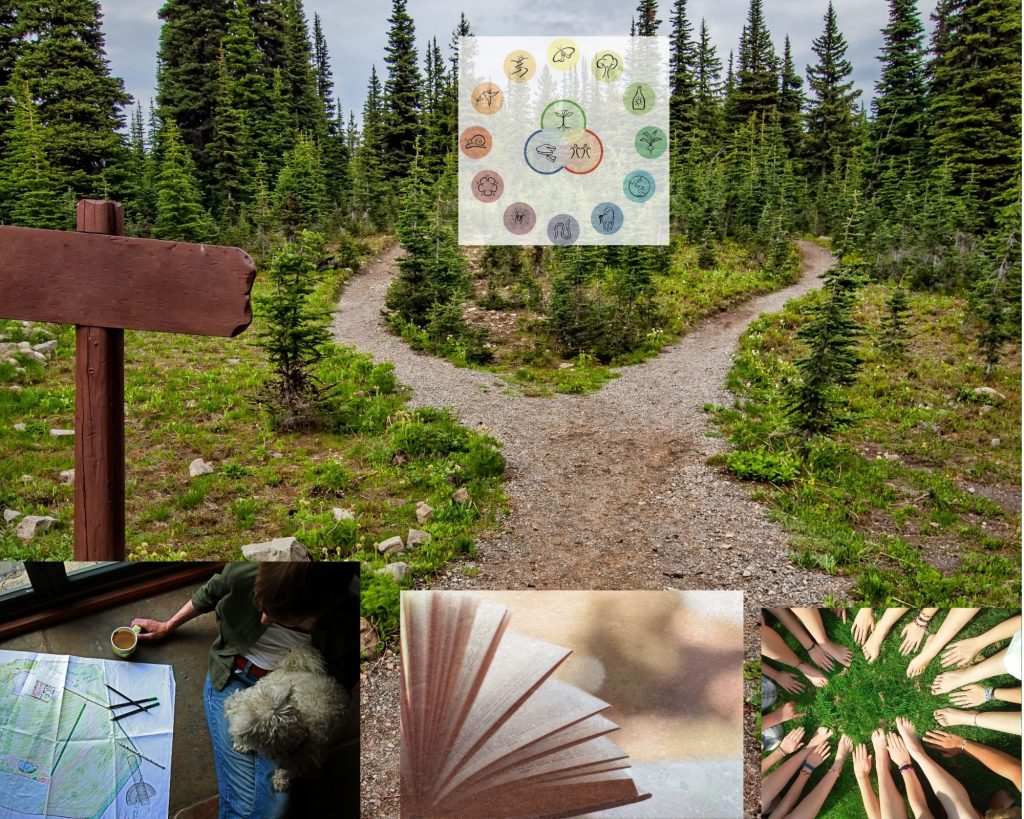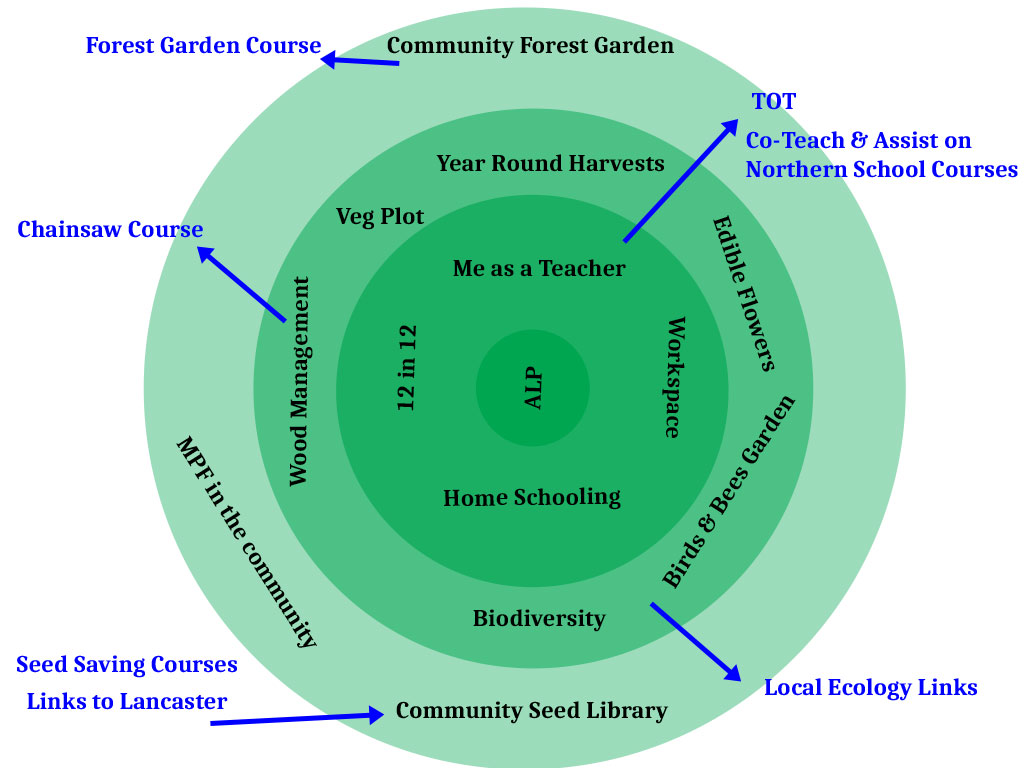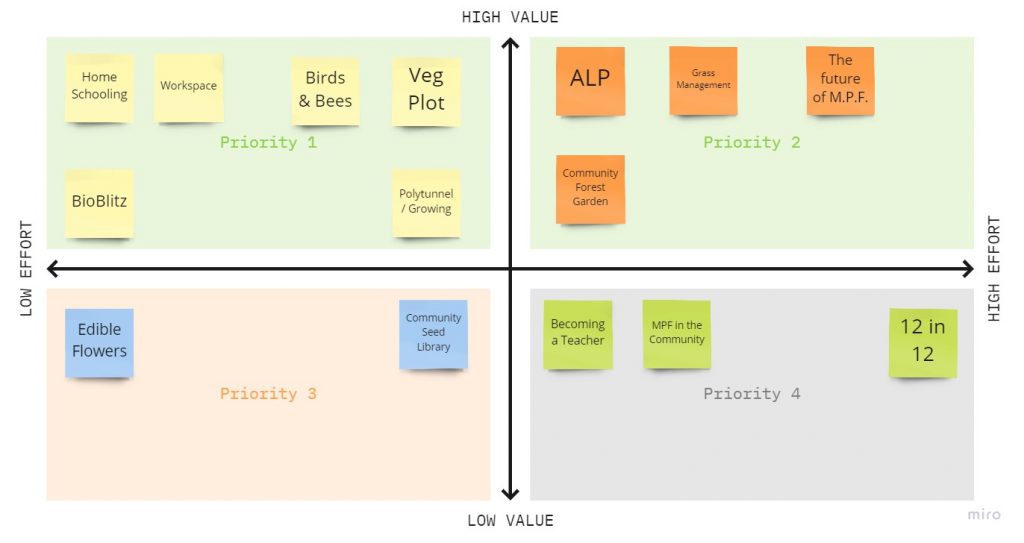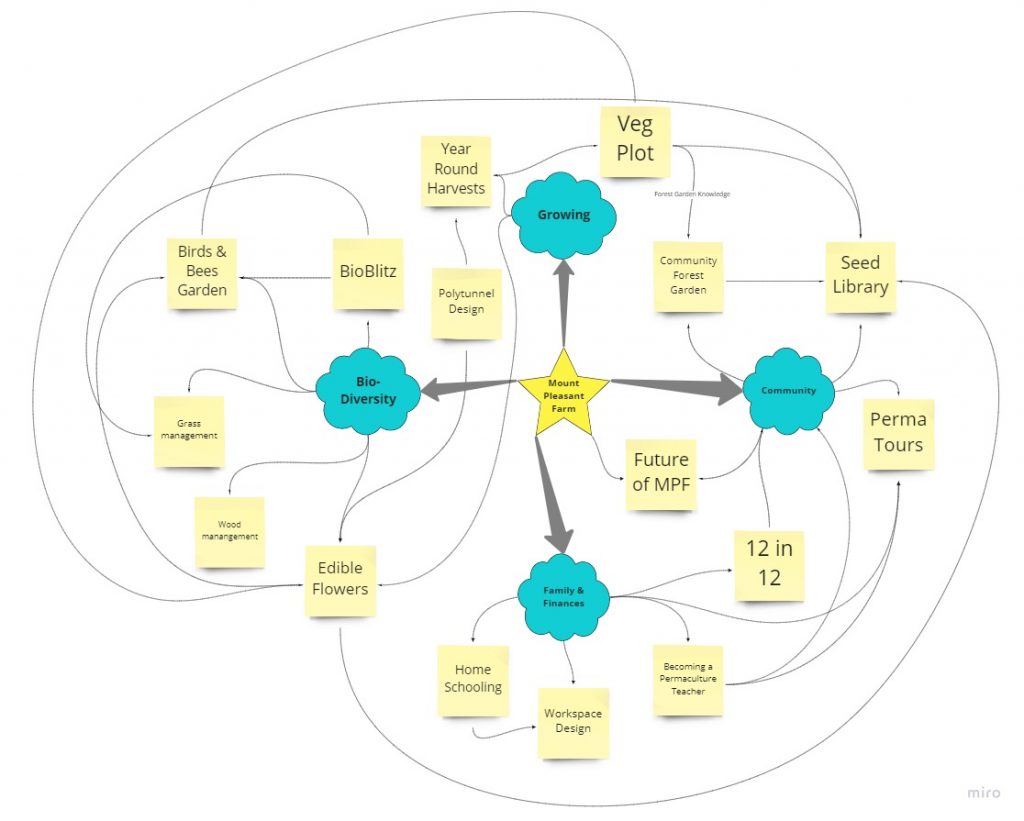My Action Learning Pathway
Theme: Bracer – Katie Gateley
Introduction
I started this design at the beginning of my diploma. Then, I didn’t progress with it. I struggled to set a plan of action, and got overwhelmed by the number of designs I wanted to do.
In Febuary 2021, I revisited the design with a fresh mind. I need a plan if I am to get the most from this diploma journey – and beyond!
Ethics
Earth Care – investigating how I can be a better caretaker of our land and resources.
People Care – investigating how I can better look after myself and my family during this process. Can I nuture my brain as well as my soul?
Fair Share – investigating how I can better share skills and knowledge and time.
Principles used to guide design
Holmgrens 12 Principles
Design Framework – Design Web
I chose this framework as it suited the ping-pong way my thoughts bounce around.
Client
Myself – a personal project
Dates
December 2020 – Ongoing
Tools Used
Design Web as a Tool; PMI; 3Ws; Vision Board; Zoning; Priority Matrix; Web of Connections; SMART Goals; Stacking; 6 Hats
Resources Used
- The Permaculture Association Diploma Website – diploma criteria
- People & Permaculture – Looby Macnamara
- Miro
- Other people’s ALPs to gain a better understanding of them, Kerry Lane, Hannah Mole, https://hedvigmurray.files.wordpress.com/2011/10/design-your-action-or-design-learning-pathway.pdf
Yields this project will provide
- A pathway that I can follow to enable me to complete my diploma
- A better understanding of how I learn and work
- A diploma design
- A framework to continue my learning post diploma
- Stronger organisational skills
- A deeper understanding of Permaculture Tools and the use of the Design Web
First Attempt – June 2020
My first attempt can be found here. Some of the points this contained also transferred to my second attempt below.
Second Attempt – February 2021
Reflection (1)
I started at the Reflection anchor as I wanted to understand why I was having such trouble with writing my ALP. This is my official second attempt, but there was much scribbling, stopping and starting to get here.
I used PMI to help order my thoughts.
PMI Analysis
| Positive | Minus | Interesting |
|---|---|---|
| First attempt made me better understand how I learn. I better understood what my study patterns were. There were some good points raised by the first version. There were some good ideas that I want to take forward. | I was using the web as an analysis tool, rather than as a framework for designing. I was hung up on how to present the deign rather than the process and content. I didn’t have clear goals defined. I didn’t link into the diploma criteria | I started the diploma with 10 design ideas, and was trying to shoehorn these into the diploma. I need to focus on what my needs are and build designs around these needs. |
Vision (2)
3 W’s – What, When, Where
I used the 3 W’s (What, When, Where) to help me clarify my vision.
What is the purpose of MY ALP?
- To give me a path to accreditation
- To include relevant and achievable designs.
- To keep me on track – stop me wandering
What is the main purpose of me doing the Diploma?
- Tie in my learning to practical designs for the farm
- Gain practical skills
- Become fluent in the use and application of design tools and Permaculture principles
- Become confident enough to demonstrate and explain to others how Permaculture can be applied to both land non-land based projects
- To build links with the Permaculture Community
- Become less isolated, and build links with my local community
What other things would I like to achieve?
- To acquire craft skills using natural materials I have on the farm
- To present my designs in an accessible way
- For my designs to be easily read and understood by someone new to the concept of Permaculture
- For my designs to be as accessible as possible
- To improve my drawing skills (freehand and computer)
When do I aim to Accredit?
To complete the diploma in 3 years (Accredit 2023)
Where will I be then?
I will be a confident designer, able to design for myself and for clients. I will be confident enough to teach and mentor others. I will have stronger links to the wider community – this includes my immediate community and the wide Permaculture related community.
VISION BOARD

Patterns (3)
| Circular | I lean best through repetition. Through trial and error. Putting practice into permanence. I may need to do things or read things several times before they stick. A designers job is never done…It is OK to do and evaluate before design is written up. Designs change! |
| Spiral | I aim to start with more simple designs and expand my skills and knowledge as I learn |
| Waves | I have peaks and troughs of activity. The journey so far has been very up and down. I would like to reduce the height and depth of the waves to a more rippling, flowing pattern. |
| Web | Many of my designs focus on myself and our farm. One of my objectives is to reach out into the wider community and become less isolated in my work. The farm and my family will remain a focal point for designs on my journey, but I aim to build connections. |
| Seasonal | Good weather and growing seasons mean that I am busy growing or working the land. I feel guilty if I waste good weather indoors. School holidays also impact my available time for design work. |
Reflection (4)
What am I like?
Self reflection is something I don’t often do. I feel we are conditioned to listen to our inner critic and find it easy to find our faults and negative patterns. As a society we sometimes find it difficult to focus on our positive traits. In a brave moment, I asked my friends and acquaintances what they thought of me. The feedback was humbling.
I am …

How do I learn?
I know that I absorb more information by doing, rather than reading. The information is better retained. I also find verbalising my findings makes them more solid and tangible. As I get older, I find that I remember less, and have to read the same thing over and over, and frequently refer back to texts. I looked at Honey and Mumfords learning styles and discovered that my learning style fits that of a Pragmatist, with elements of activist.
Pragmatists are keen on trying out ideas, theories and techniques to see if they work in practice. They positively search out new ideas and take the first opportunity to experiment with applications. They are the sort of people who return from courses brimming with new ideas that they want to try out in practice. They like to get on with things and act quickly and confidently on ideas that attract them. They tend to be impatient with ruminating and open-ended discussions. They are essentially practical, down to earth people who like making practical decisions and solving problems. They respond to problems and opportunities ‘as a challenge’. Their philosophy is “There is always a better way” and “If it works it’s good”.
Activists involve themselves fully and without bias in new experiences. They enjoy the here and now, and are happy to be dominated by immediate experiences. They are open-minded, not sceptical, and this tends to make them enthusiastic about anything new. Their philosophy is: “I’ll try anything once”. They tend to act first and consider the consequences afterwards. Their days are filled with activity. They tackle problems by brainstorming. As soon as the excitement from one activity has died down they are busy looking for the next. They tend to thrive on the challenge of new experiences but are bored with implementation and longer term consolidation. They are gregarious people constantly involving themselves with others but, in doing so, they seek to centre all activities around themselves.
LIMITS & HELPS (5) & INTEGRATION (6)
I brainstormed what my Limits were and listed them out. Then I took each Limit in turn and thought about how I could over come these limits. What helps do I already have? What minor changes do I need to make? What major changes do I need to make? Are their any unsurmountable Limits? I then looked at how these limits and helps could be converted to possible designs that would help me to complete the diploma and get work done on the farm.
| LIMIT | MINOR CHANGE | MAJOR CHANGE |
|---|---|---|
| Available Time | Set time aside each week | |
| Disorganised | Have a visible list of what needs to be done. Prioritise the list. | |
| Juggling too many projects | Have a visible list of what needs to be done. Prioritise the list. List out what I get from each project? Is it beneficial to me? | |
| Lack of suitable work space | Design my workspace Set parameters with family | |
| Guilt – so much to do | Have a visible list of what needs to be done. Prioritise the list. Display vision boards | Timetable reading time into each day – self care!!! |
| Too many ideas | Voice notes/notes on phone Have an ideas park | Create a checklist for ideas, Do they fulfil my ALP criteria? Will they help progress other ideas? |
| Easily Distracted | Clear desk. Set one activity at a time | |
| Lack of Confidence | Take time to read Guilds – talk things over | Assist on PDC courses, mentor others. Work on community projects. |
The solutions to my limits are all very simple! The change to my habits will be the hardest thing to overcome, especially my lack of focus and ability to be distracted by the smallest thing
ACTION (8)
- Draw up a Weekly Timetable – even if I only spend 30 mins a week on Diploma, it is progress and is keeping momentum
- Create Ideas Park – I can’t include EVERYTHING in the diploma – some things will have to wait
- Have at least one Guild meeting a month – and have something to report back on!
MOMENTUM (9)
What is going to stop me progressing and what do I need to do to solve this?
- Getting Bogged down in details – Pattern to detail! Start with bigger picture and drill down.
- Stop Enjoying it – Make sure I am working on projects I enjoy and that are relevant.
- Seeing it as a chore – Make writing up a treat, eat choc, drink tea, make time to sit and read!
- Being too prescriptive – have a script, but be prepared to improvise!
- Recognise that Growing season is a slow writing/diploma season. Just do a little when I can.
IDEAS (9)
I created a Zone Map of all my design ideas to get them out of my head and onto paper (screen). The blue are further learning or links I need to make I need to do in order to progress the design.

I analysed all the ideas to see how and if they fitted into my vision for the diploma, my farm and my life. The results are included in this table. There are more than 10 designs – but only 10 will be selected for my final portfolio. Designing doesn’t stop at the end of the diploma, perhaps that is when it really begins?
My priority 4 designs are designs that I consider to be ongoing, to work towards.
Principles (10)
I used the checked that my ideas for designs, and my direction fit with the principles.
| Observe & Interact | Read back over my work. Look at other ALPs |
| Catch and store energy | Note ideas and lightbulb moments as they happen. If on a roll, allow myself to go with it (if time) – if not, make good notes to come back to. |
| Obtain a yield | Knowledge, contacts, networks, friendship, Confidence |
| Apply self regulation ad accept feedback | Tomas, KT, Guild, Reflection |
| Use renewable services & resources | Re-use books and information. Share the info. |
| Produce no waste | Park ideas – they may be useful later |
| Design from patterns to details | Start wit the big picture and drill down to what’s needed. Don’t get hung up on specifics at start. |
| Integrate rather than segregate | Tie projects into the bigger picture |
| Use edges and value the marginal | Guild |
| Use and value diversity | KT Don’t just focus on the farm. Multiple projects at once. Guilds |
| Small and slow solutions | Do a little bit each week. |
| Creatively use and respond to change | Adapt schedule and project timings to suit needs and seasonal patterns. Go with the flow. |
Action (11)
“You start with your nose, then your hands, your back door, your doorstep” – you get all that right, then everything is right. If all that’s wrong, nothing can ever be right.”
Bill Mollison 1991
I used a Priority Matrix to help me prioritise my ideas. This has helped me to focus my time and energy into what needs to take priority. It also helped to clarify that some things can wait!

One of my key goals of my design write ups is to make them as accessible as possible. I recognise that this is an area I need assistance with. To help me with this, I have booked a tutorial with KT Shepherd as she is both tech savvy and has a greater awareness of accessibility issues.
Patterns, Reflection & Momentum (12)
I scheduled regular tutorials to ensure that I maintain momentum, but also to force me to stop and reflect. I need to be reminded to stop and reflect as I have a tendency to quickly move on to the next task without stopping to fully think.
The regular tutorials will add structure to my diploma journey.
Integration (13)
I felt it was important to show how my projects link together. The projects are focussed around Mount Pleasant Farm and have four specific areas of focus. Growing, Bio-Diversity, Community and Finance and Family.
The diagram below endeavour to show how the projects link together.

Action (14)
To give me a time frame to work to I have set myself SPARE goals (Specific, Positively Stated, Aligned, Realistic, Ethical).
Community Forest Garden
I will complete the design write up and include feedback from the group, incorporating any changes that have been made to the design as we have worked on the site. This will be completed by the end of September 2021. All members of the group will be given an opportunity to give their feedback.
Polytunnel design
I will draw and draft
Pause (15)
Celebration
Appreciation (16)
Of myself & of others
Reflection (17)
How did my Diploma go? 6 Hats
Did my ALP help?
Vision (18)
Where do I do next?